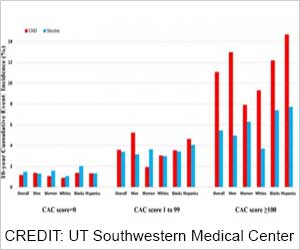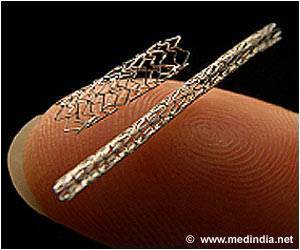Having a high coronary artery calcium (CAC) score is associated with greater risk for heart attack, and is not an indicator of stroke. Calcium is part of the fatty plaque that builds up in arteries supplying blood to the heart leading to blockages, and causing heart attacks or strokes.

TOP INSIGHT
Coronary artery plaque predicts the risk of cardiovascular disease (ASCVD) events, including heart attack and stroke. Moderate to high levels of calcified plaque increases the risk of heart attack by two fold. It helps in decision-making aid for primary prevention.
Read More..
"In our study, there was a twofold greater risk of heart attack than stroke at CAC levels at or above 100, a score indicating moderate to high levels of calcified plaque”, says Parag Joshi, M.D., a cardiologist and assistant professor of internal medicine at UT Southwestern and senior author of the study. "That held true for Black, white, and Hispanic men and women."
Women and Black individuals generally have higher stroke risk, Joshi says.
"In fact, while the calcium score may not be a strong predictor of stroke risk for most, for some reason it did well in predicting strokes in Black participants," says Anurag Mehta, M.D., the first author of the study, formerly at UT Southwestern and now at Emory University School of Medicine.
The findings could help guide health care providers as they decide how aggressively to treat patients with risk factors such as high cholesterol and blood pressure but who have never had a major cardiovascular event.
Joshi's study evaluated data from more than 7,000 participants in two large studies - the Multi-Ethnic Study of Atherosclerosis (MESA) funded by the National Institutes of Health, and the Dallas Heart Study at UT Southwestern.
For participants with a calcium score of zero, there was a similarly low risk of either a stroke or a heart attack in the coming 10 years - less than 2 percent for either event among all study participant categories, according to the study.
The risk level for both heart attacks and strokes rose a bit for those with scores of 1-99, yet still remained below 6 percent - increasing about equally for both and across most demographic groups. At this level, women did have a greater increase in the risk for stroke than for heart attack, whereas men had higher heart attack risk than stroke.
Greater differences were found when the CAC scores rose to 100 or above, with heart attack risk twice as high as stroke risk for the entire study population. While 10-year heart attack risk jumped above 12 percent for men and over 14 percent for Hispanic individuals, heart attack risk for women was approximately 8 percent, according to the study.
Meanwhile, stroke risk remained below 8 percent across all groups, although women, Black, and Hispanic people had higher risk than men and white participants.
For doctors and patients, the findings could help tilt the scales either toward or away from using statin drugs to lower cholesterol in cases where the decision is not clear-cut from factors such as age, sex, cholesterol, systolic blood pressure, and smoking history.
Patients are sometimes reluctant to begin what is likely to become a lifelong drug therapy, Joshi says. "If you think your patient should be on a statin and your patient doesn't want to take it, this can be a good arbitrator of that," he says. "Our findings also highlight some of the nuance between heart attack risk and stroke risk and how our patients might consider those two risks in their decision making."
Source-Eurekalert
 MEDINDIA
MEDINDIA




 Email
Email










